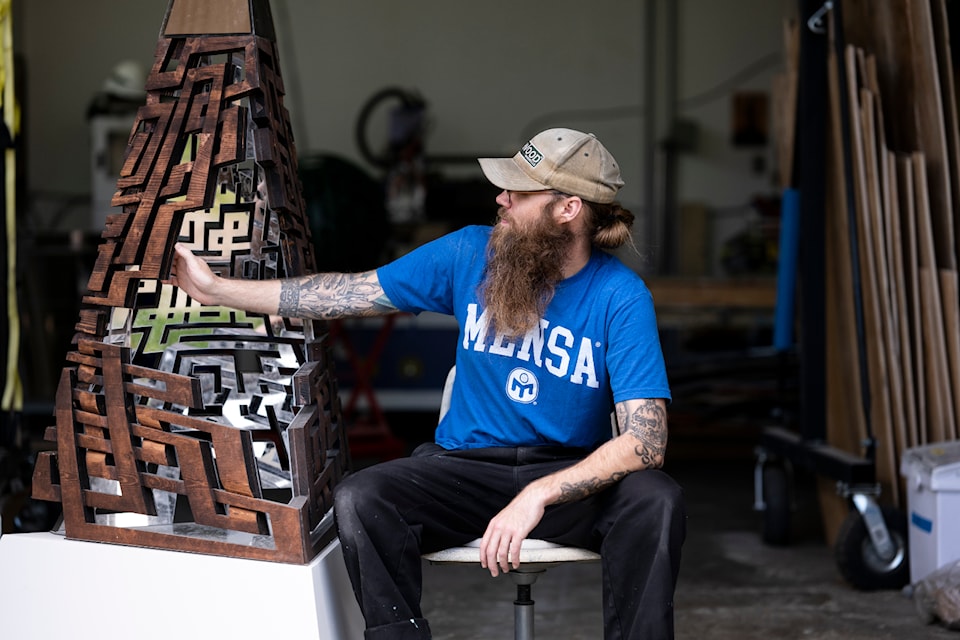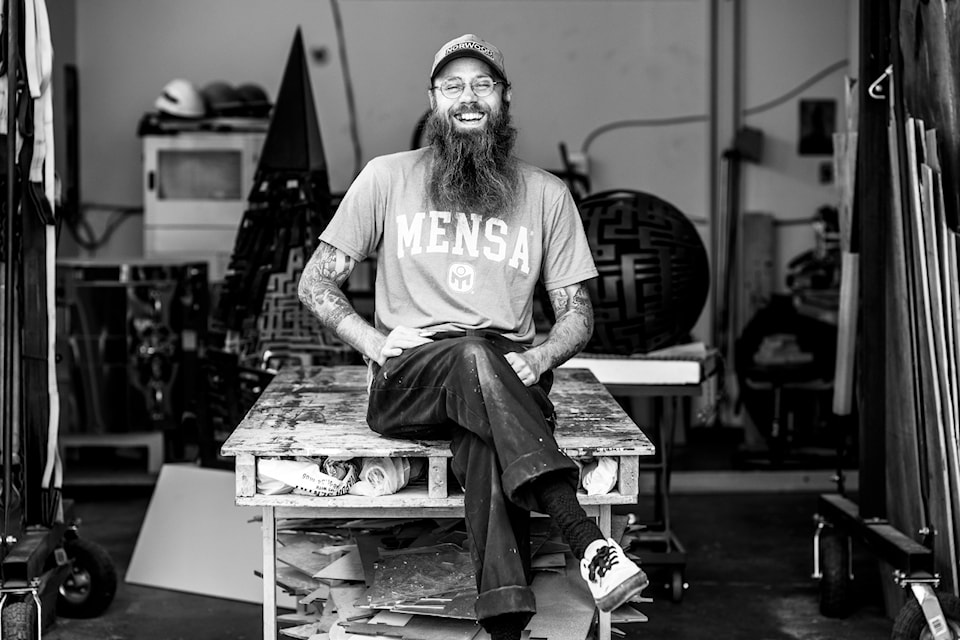The Dutch graphic artist M.C. Escher once said, “For me, it remains an open question whether (this work) pertains to the realm of mathematics or to that of art.” The same question applies to the work of Mark Ollinger, a 35-year-old Chemainus-based sculptor who uses unconventional geometric designs and graffiti art as a base for his artistic practice.
Not only are Mark’s designs unconventional, so too are his tools. When I visited his studio, a massive computer numeric control (CNC) laser cutting machine hummed in the corner, its high-power laser beam flashing as it cut a pattern into a wooden surface. On one side of the studio were pieces of intricately cut wood, waiting to be assembled, while on the other side sat two completed sculptures: a sphere and an obelisk. The sculptures resembled Chinese puzzles or mazes with their tight, geometric designs. There was something so compelling, so unique about these wooden pieces and I wanted to know more about how Mark got his start.
Mark was first exposed to woodworking through his father’s work as a carpenter and, over his career, has combined his knowledge of that trade with his artistic designs. By his early teens, he was creating art daily and working as a freelance graphic designer and silkscreen artist.
“I gravitated towards self-expression instead of team sports,” he said. “I rode skateboards a lot, and I became absolutely obsessed with graffiti, the idea of a single line…and the fact that I could take a word and then turn it into this thing.”
Each of his works uses a letter or words as a foundation for the design and begins and ends with a single line.
“When I was creating graffiti, the word I wrote was apathy,” he said. “I was just over it in school; I was pretty apathetic. But then there was a shift, and I started writing ‘a path.’”
After he graduated from high school, Mark founded Duality Clothing, a skateboard/snowboard apparel company, and continued his daily practice of painting in a Vancouver studio.
“For the next seven years, I ran this business,” he said. “I thought – wrongly – that it was going to free up my time so I could create more art.”
“When I was creating graffiti, the word I wrote was apathy...But then there was a shift, and I started writing ‘a path.’”
By 2014, Mark had returned to his original passion: creating paintings and sculptural works. I Who Have Nothing, a 243- by 182-cm acrylic and aerosol painting on canvas, is a seminal work from this period that now hangs in his home. A single turquoise line spells out a quote from an influential rap song; the maze appears to rise over a background of burgundy, yellow and gray triangles.
“This is one of the biggest accomplishments in my art career so far,” said Mark. “It took me almost 18 months to make, all by hand.”
As the line weaves over and under itself, it intersects in two places: where it goes over and where it goes under. This, for Mark, represents the visualization of a human lifetime: “Every experience you have, whether it’s negative or positive, creates the opposite down the line.”
As Mark’s work evolved, the use of digital designs and a CNC laser cutting machine allowed for more complexity in his designs. In 2015 and 2016, he created a body of unsanctioned street work which he installed abroad in Melbourne, San Francisco and Los Angeles, and in Canada in Vancouver, Toronto and Montreal.
It all began with an invitation to Australia.
“I was dating a girl, and she was going to Australia for a month,” said Mark. “She asked me if I wanted to go. I said if I come, I’m going to build these street sculptures.’”
Installed Banksy-style in the middle of the night, these sculptural pieces gained notoriety for Mark, leading to articles in art and culture publications like Gross, Beautiful Bizarre and Hyperallergic magazines. Eventually, the coverage led to important exhibitions in the U.S. and Canada.

Returning home to Vancouver, Mark’s work began to grow and evolve into three distinct and ongoing series: Illusion & Reality, Enterdimensional and String Theory.
“Illusion & Reality focuses on the deconstruction of optically distorted two-dimensional images,” explained Mark. “These works focus on taking shapes and ‘punching’ optically distorted images through them in order to further the illusion and create spontaneous imagery in the combination of the two or more shapes.”
Enterdimensional works involve the “birth” of a two-dimensional image into the third dimension.
“I take the imagery that started as acrylic on canvas and ‘pull’ that imagery out of the panel,” Mark said.
The green sphere in Mark’s studio is from this series, and is a counterpoint to a red pyramid sculpture.
“Together they embody the idea of dominance versus the idea of coexistence. The red said ‘ego,’ representing anger, while the green said ‘eco,’ representing nature.”
String Theory works are focused on constructing 3D objects out of the maze concept. “I’m taking the ideas that I had and expanding on them in a 3D way, wrapping them around shapes and becoming very complex with the process,” he says.
“I’m trying to create an objective observation of the conscious experience. That’s why it’s so simple. That’s why it’s one single line: it all goes back to the path.”
In 2021, Mark moved to Chemainus to continue his practice outside of an urban setting.
“It’s a funny thing,” he said. “I’m just some obscure dude doing these things out here. One of my neighbours is a mechanic and the other is a millwright who works at the sawmill. What’s so great is that we all have this side of ourselves that is unique, that differentiates us from others…small towns are filled with people doing really unique things.”
Though he recently rented a studio space in Brooklyn, New York, Mark plans to remain in Chemainus, become involved with the community and continue to expand upon his work. Before I left his studio, we turned to his newest piece, Gnosis, a 190-cm tall, pyramid-shaped stained pine and acrylic mirror sculpture.
“It doesn’t fit any of my previous series,” he admitted, and I couldn’t help but peer into the mirrored interior.
“When you look in, it becomes this sort of infinity mirror, because we can’t really understand ourselves,” said Mark. “This is what’s known as the ‘golden loop,’ as in Escher’s drawing of a hand drawing a hand, that occurs when a system self-references.”
In all of his works, Mark wants his viewer to see the path – the single line. “I’m trying to create an objective observation of the conscious experience. That’s why it’s so simple. That’s why it’s one single line: it all goes back to the path.”
As for whether Mark’s work, like Escher’s, should be categorized as mathematics or art, the answer, in my mind, is another question: Why can’t it be both?
This feature is from the summer 2024 edition of Boulevard Vancouver.



